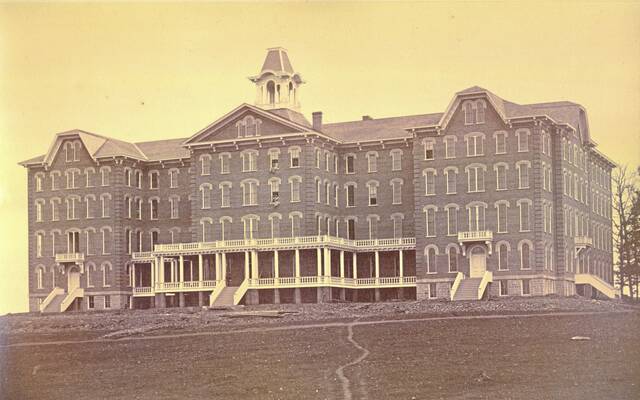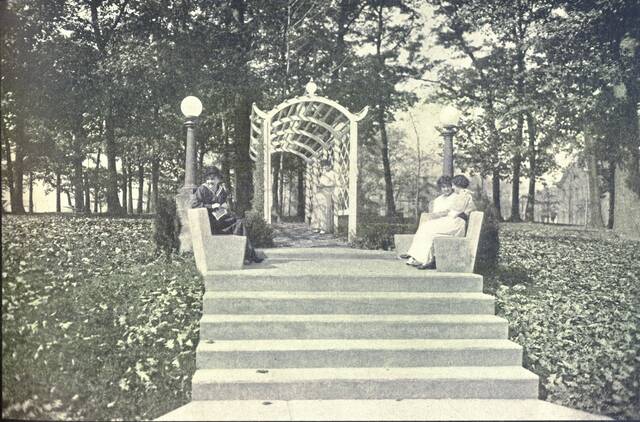Teacher-training roots, diverse appeal celebrated with exhibit in IUP's 150th year
The town of Indiana, seat of Indiana County government, also has been a key center of higher education in Western Pennsylvania for 150 years.
The ongoing story of Indiana University of Pennsylvania, since its beginning in 1875 as Indiana Normal School, is the subject of the university’s current sesquicentennial celebration and of an exhibit running through Dec. 6 in the University Museum: “IUP@150: Let’s Meet in the Oak Grove.”
“At the beginning, the school started in John Sutton Hall, and the exhibit is being held in John Sutton Hall,” said the show’s curator, Harrison Wick, IUP Special Collections librarian and university archivist.
The building, constructed in 1874, “has always been there,” he noted. “It’s a very nice consistency.”
That multi-story edifice was the sole structure on campus when Indiana Normal School took in its initial class of 225 students in May 1875.
Male and female students who came to be instructed in the profession of teaching were housed in separate wings, Wick said, but there was plenty of space left over for classrooms as well as accommodations for faculty and administrators.
The hall’s expansive Blue Room originally served as the dining hall.
By the 1911-12 academic year, enrollment had increased to 1,202.
In 1920, the school was purchased by the state of Pennsylvania. Renamed Indiana State Teachers College, it awarded its first collegiate degrees in 1927 and its first graduate degrees 30 years later.
In its early decades, Jane Leonard was another constant at the school. She was the preceptress — equivalent to the dean of women or vice president of student affairs — when the doors opened in 1875, and she also taught English and history. Outlasting all other original faculty members, she retired in 1921.
Popularly known as “Aunt Jane” and described as the school’s “George Washington,” she provided advice and encouragement to students who gravitated to her apartment in Sutton Hall.
The year after her retirement, the native of Clearfield County, at 81, ran to represent her adopted county in Congress. Though she was defeated, she captured 37% of the vote.
She was allowed to keep her Sutton apartment, and that’s where she died in her sleep April 6, 1924.
Wick noted three successive campus buildings have been named in her honor or memory.
“She was the cement that held us together,” he said.
The first Leonard Hall, constructed in 1903 while the preceptress remained hard at work, was rebuilt after it burned in 1952. The latest Leonard Hall, dedicated in 2022, houses IUP’s College of Arts, Humanities, Media and Public Affairs in the former humanities and social sciences building near Sutton Hall.
Sutton Hall was named such in 1903, in honor of John Sutton, an Indiana merchant who sold some of the original acreage occupied by the university and who served as the first president of the school’s board of trustees.
An adjacent campus building, since displaced by Stapleton Library, was named for Sutton’s son, Thomas.
A stained-glass window and tower-topping spire from Thomas Sutton Hall are among IUP artifacts on display in the museum exhibit, in John Sutton Hall Room 111. The show also includes a time capsule that was created in 1975 for the school’s centennial.
The exhibit shines a spotlight on Bianca Parker, the school’s first known African American student.
The daughter of a formerly enslaved man who settled with his family in Ripley, Ohio, Parker studied music at Indiana Normal School from 1891 to ‘93 and graduated in 1898 from the private Kimball Union Academy in New Hampshire.
She taught music in Kentucky, Ohio and Missouri and died in 1930.
Wick said IUP has continued to attract a diverse range of students looking for an affordable education.
“We’ve always been about teaching and reaching out to the first-generation college student,” he said.
Between World War II and the Korean War, the school experienced a spurt in growth, fueled in part by veterans taking advantage of the G.I. Bill, Wick said.
In 1959, it became Indiana State College, offering a broadened curriculum with a student enrollment of 3,317. It gained university status in 1965, with enrollment jumping to 6,334.
Enrollment climbed to 15,668 by 2012 before falling off to a recent low of 8,832 in 2022. IUP subsequently regained some ground, with enrollment of 9,254 students in 2023 and 9,081 students last fall.
IUP’s campuses and educational offerings have continued to evolve.
IUP also offers programs at three regional campuses: IUP at Northpointe, in South Buffalo Township, Armstrong County; IUP Pittsburgh East, in Wilkins Township, Allegheny County; and IUP Punxsutawney, home to the university’s Academy of Culinary Arts.
The Kovalchick Convention and Athletic Complex debuted in 2011, and the Kopchick College of Natural Sciences and Mathematics building opened in 2023.
In conjunction with the sesquicentennial, IUP launched its largest fundraising campaign, Impact 150 — so far amassing $81.2 million toward the goal of $150 million.
Some of those funds will help with establishing a proposed college of osteopathic medicine, which has been granted “candidate” status from the American Osteopathic Association’s Commission on Osteopathic College Accreditation.
“IUP has weathered many storms over the past 150 years, but it has always had an incredible sense of pride and optimism, independence and commitment to student success,” university President Michael Driscoll said.
“There’s a story for everybody,” said Wick. “That’s what I love about IUP.”
Jeff Himler is a TribLive reporter covering Greater Latrobe, Ligonier Valley, Mt. Pleasant Area and Derry Area school districts and their communities. He also reports on transportation issues. A journalist for more than three decades, he enjoys delving into local history. He can be reached at jhimler@triblive.com.
Remove the ads from your TribLIVE reading experience but still support the journalists who create the content with TribLIVE Ad-Free.


